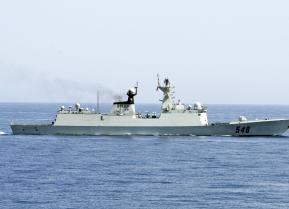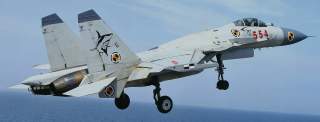China's New Aircraft Carrier Shows All the Signs of a Killer. Here Is What We Know.
China’s next aircraft carrier is likely to boast a lot more combat power.
According to the aforementioned SCMP article, Chinese engineers believe they solved this problem by developing an integrated propulsion system (IPS), which would generate enough power to use EMALS. “The obstacle … was whether a conventionally powered carrier would be able to support EMALS,” a source whom SCMP said was close the PLA’s equipment department told the paper. “Now that problem has been solved.”
China’s next aircraft carrier is likely to boast a lot more combat power.
On June 20, China Shipbuilding Industry Corporation (CSIC), the firm that makes China’s aircraft carriers, posted an image on its social media accounts showing three aircraft carriers. On the right and left were the Liaoning—China’s first carrier, which was built by Ukraine—as well as China’s first domestically-built carrier.
Unlike those carriers, which have a ski-jump launch systems, the mysterious third carrier in the middle of the image had a flat flight deck with three catapult-like devices. This suggests it relies on a catapult launch system.
(This first appeared last month.)
As the Hong Kong–based South China Morning Post pointed out, the image appeared to be an artist’s drawing rather than an actual photo of a new carrier. Furthermore, CSIC quickly removed the image from its social media accounts.
Nonetheless, Chinese state-run media outlets, including the People’s Liberation Army Daily (the military’s newspaper), ran stories about the photo. This suggests that Beijing’s third carrier is almost certain to have a catapult launch system.
If China’s third carrier uses a catapult launch system—making it a Catapult Assisted Take-Off, Barrier Assisted Recovery (CATOBAR) carrier—it will boast far more combat power than Beijing’s current vessels. This type of launch system allows the carrier to launch and recover larger and much heavier aircraft.
Besides allowing for a greater variety of aircraft, planes operating from a CATOBAR carrier can carry more weapons and extra fuel for longer trips. They can also use much larger airborne early warning aircraft to protect the ship.
Additionally, CATOBAR carriers can launch aircraft at a faster rate. Thus, CATOBAR carriers can project more power more quickly and with better protection.
Thus far, Beijing has relied on its two Short Take-Off, Barrier Assisted Recovery carriers. These types of launch systems restrict the weight of the aircraft that can take off from the carriers. That means less planes can operate from them and the ones that do will carry less weapons and fuel. Thus, they won’t pack as large of a punch.
That China’s third carrier will feature a catapult launch system isn’t a huge surprise. As South China Morning Post noted, “satellite images released earlier showed sites in Wuhan, Shanghai and Liaoning where the new system might have been tested.”
There have also been reports that China’s carrier-based fighter, the J-15, was being modified to use the catapult system.
More telling, in November 2017 the South China Morning Post (SCMP) reported, citing “military sources,” that Beijing had achieved a technological breakthrough that would allow its next carrier to use a electromagnetic aircraft launch system (EMALS) without the use of nuclear power.
Recommended: China's H-6K: The 'Old' Bomber That Could 'Sink' the U.S. Navy
Recommended: Why an F-22 Raptor Would Crush an F-35 in a 'Dogfight'
Recommended: Air War: Stealth F-22 Raptor vs. F-14 Tomcat (That Iran Still Flies)
The use of EMALS means it would have a catapult launch. Most of America’s current carriers use steam catapult systems, “where steam explodes into a piston attached to the plane's landing gear, powering it off the deck.”
But the Ford-class carriers it is currently building use electromagnetic catapults to power the launch.
As CNN notes, “Aircraft launched by electromagnetic catapults can get airborne quicker and with greater quantities of fuel and ammunition, giving them an advantage over planes launched by standard steam catapult.”
Like the difference between catapults and ski jumps, electromagnetic catapults allow for larger aircraft to be launched at a faster rate compared with steam powered catapults. EMALS also supposedly require less maintenance.
The problem is that electromagnetic catapults require more power than steam power systems. And, steam catapults themselves require tons of power, which is why most (but not all) CATOBAR carriers are powered by nuclear reactors.
According to the aforementioned SCMP article, Chinese engineers believe they solved this problem by developing an integrated propulsion system (IPS), which would generate enough power to use EMALS. “The obstacle … was whether a conventionally powered carrier would be able to support EMALS,” a source whom SCMP said was close the PLA’s equipment department told the paper. “Now that problem has been solved.”
The article said that the breakthrough came when using a “medium-voltage, direct-current transmission network” rather than a system using an alternating current. This required a “complete overhaul of the energy supply and distribution system – from steam boilers to the energy storage device,” said Wang Ping, an expert at the Institute of Electrical Engineering under the Chinese Academy of Sciences in Beijing. The U.S. Zumwalt-class destroyers use an integrated propulsion system.
In building aircraft carriers, China appears to be following a policy of gradual improvements. The first domestically built carrier was very similar to the Liaoning. The next one, it appears, with have the electromagnetic catapult launch system. It is widely speculated the third carrier will be nuclear-powered.
Zachary Keck (@ZacharyKeck) is a former managing editor of the National Interest.
Image: Creative Commons.


